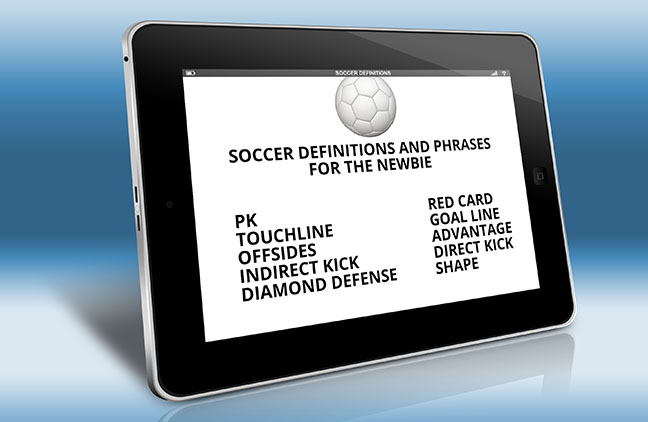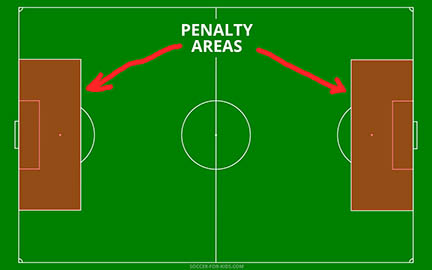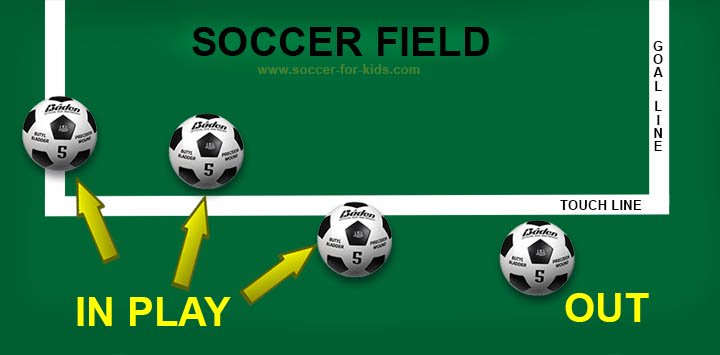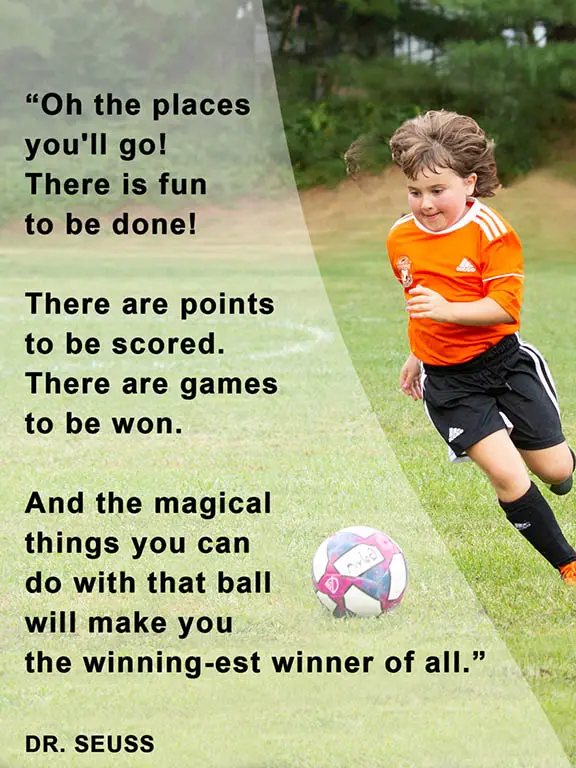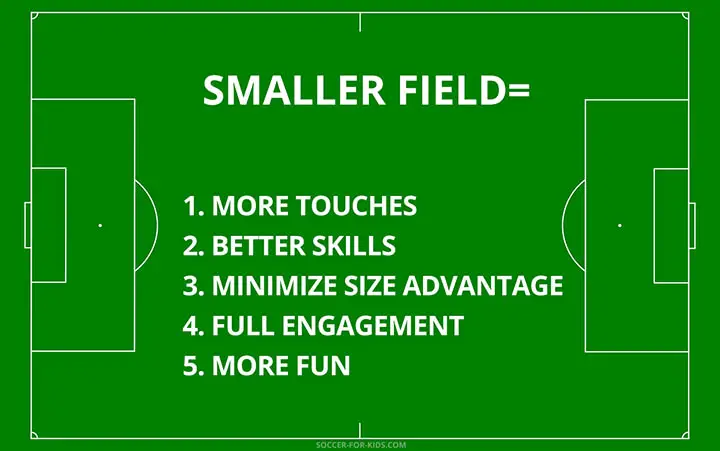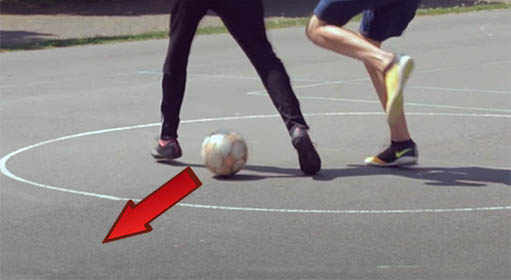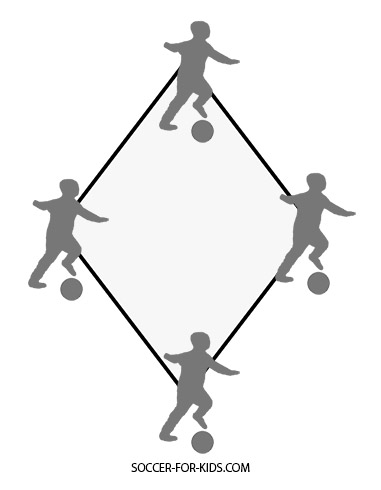Youth Soccer Words, Phrases, Terms, and Definitions
Thanks for vising the Soccer-For-kids dictionary of soccer words, phrases, and definitions. Soccer lingo can be confusing, but this glossary of soccer terms is easy to understand and will help you grasp and enjoy the game to a much higher degree.
Here is the list of soccer words and phrases, accompanied by their meaning. If there are any soccer terms that are missing, feel free to notify me: bruce (at) soccer-for-kids.com
ADVANTAGE. There are certain situations when a referee does not call a foul. It's not made because the the opposite team had an advantage in letting play continue without stopping. The law of advantage directs the referee to allow play to contain, without stopping play for a foul if the stoppage of play would benefit the team that committed the violation.
ASSIST. When a player teammate passes or heads the soccer ball to a teammate who then scores a goal, it's called an assist.
ATTACKER. Usually, we think of an attacker as an offensive player who is trying to score, but an attacker can also be anyone who is in possession of the soccer ball.
BANANA KICK. When a ball is kicked and it curves as it travels through the air, following the arched shape of a banana. With a bit of practice you can learn to "Bend it Like Beckham" (David Beckham) by putting a spin on the ball as you kick. Watch the short video clip below of a banana kick.
BOOM BALL. A long distance kick toward the opponents goal, usually with no specific strategy in mind except to get the ball in a more offensive position. It can create an an opportunity to score if the attacking team regains possession of the ball.
BRACE. A brace is when a player scores two goals in a single soccer match. Where did the term brace come from? It's an Old English term from when a hunter successfully shoots down two of the same species in one outing.
CLEAN SHEET. A clean sheet has been accomplished when the combined efforts of the goalie and the defensive players have allowed no goals, in other words a shutout. Clean sheets can be used as a benchmark for coaches to rank and track the effectiveness of players on the team.
 Both defenses earned a "clean sheet."
Both defenses earned a "clean sheet."CLEATS. Specialized footwear with rubber or plastic protrusions that help provide traction as kids run around and change direction on the soccer field. Soccer cleats are not required to be worn, but essentially all soccer players do wear them. Playing without cleats increase the likelihood of injuries.
CORNER KICK. When the ball goes over the end line and is last touched by the defending team, a corner kick is awarded to the offensive team. Corner kicks are "direct" kicks and will count as a score with or without another player making contact with the ball before it enters the goal. The ball must be placed withing a small arc in the corner on the side of the filed where the ball went out of bounds.
CROSS. Rather than like when the ball is kicked forward down the field or backwards toward one's own goal, a pass is called a cross when it is kicked in across the from the sides of the field. When a player with the soccer ball in the offensive zone is out wide near the sideline the cross is an effective way to get the ball into the penalty areas and increase the likelihood of scoring a goal.
CROSSBAR. The horizontal bar that connects the two side posts of the soccer goal.
 Soccer goal crossbar
Soccer goal crossbarDEFENDER. A player in the teams formation whose primary duty is to stay relatively closer to her own goal to prevent the other team from scoring a goal. Some defenders will push forward on the filed to support the offensive efforts of her teammates.
DIRECT KICK. A direct kick is one where the ball can be kicked directly into the goal without touching another player first and will count as a valid goal.
DROP KICK. A goalie may do a drop kick rather than a punt to clear the ball away from the penalty area. With a drop kick the soccer ball is dropped from the goalie's hands and kicked immediately just after hitting the ground. Another phrase for this type of kick is a half-volley.
FORWARD. As the name indicates, forwards push forward toward their opposition's goal. Forwards (including "strikers" primary task to put pressure on the opposing team's defense and score goals.
FORMATION. A big part of the strategy of winning soccer is the way the players are positioned on the field. Here's a complete post on understanding formations and positions. An example of a small-sided (youth) soccer formation is below.
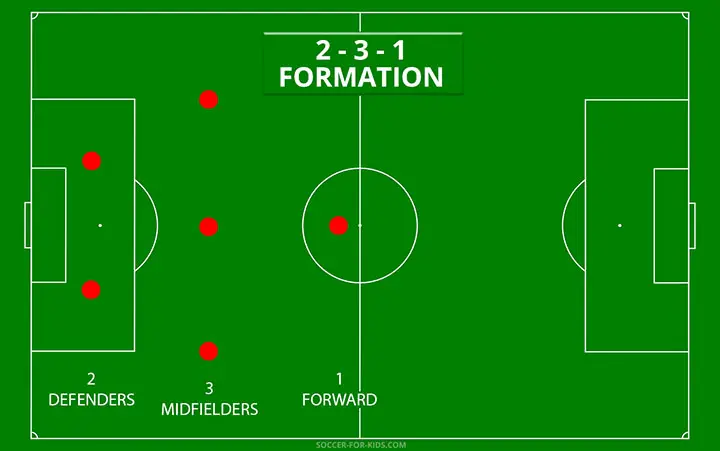 Example of 2 - 3 - 1 soccer formation for 7 versus 7.
Example of 2 - 3 - 1 soccer formation for 7 versus 7.There are 2 defenders, 3 midfielders, and 1 forward.
With the exception of the very youngest toddler and preschool soccer matches where there is no goalie, the goalie is not mentioned as part of the formation because that position is universal in all soccer formations.
FREE KICK. When a team is awarded a free kick, the opposition must keep a distance of 10 yards. Free kicks are awarded for several reasons. Free kicks are used for starting a half, corner kicks, goal kicks, penalty kicks, and for a foul being committed outside the penalty areas.
There are two kinds of free kicks. See Direct Kicks and Indirect Kicks in this glossary.
FULLBACK. The fullback position is a defender that generally is positioned back behind the midfielders in the formation. Fullbacks can contribute on offense when the ball is deep within the opponents territory.
GOAL. When the entire soccer ball fully crosses the plane of the goal line, below the crossbar, between the two side posts, as long as no fouls were committed. One point is awarded for scoring a goal.
GOAL AREA. The goal area is also called the six-yard box and it's sole purpose is to limit where the soccer ball can be placed in order to make a goal kick.
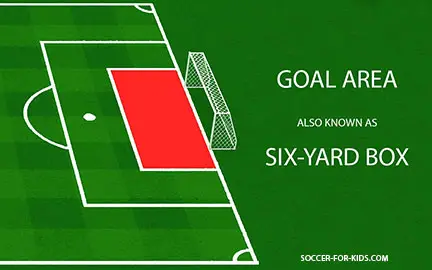 On a 6-kick/goal kick the ball is placed anywhere within this box.
On a 6-kick/goal kick the ball is placed anywhere within this box.GOAL KICK. Also called a "6 kick" because the ball must be placed on the edge of or within the 6 yard box. The goal kick is a free kick that is awarded to the defending team when the offensive team was the last to touch it before it went over the end line.
GOALIE. The term goalie is a shortened version of goalkeeper and is also called the keeper. The goalie's main tasks are to keep the ball out of the net and to distribute the ball effectively after a save or from taking the six yard (goal) kick .
The goalie is the only player on the field that can use their hands on the soccer ball, provided the ball is within the penalty area.
GOAL POSTS. The goal posts are the two verticals poles that support and attach to the cross bar section of the soccer net.
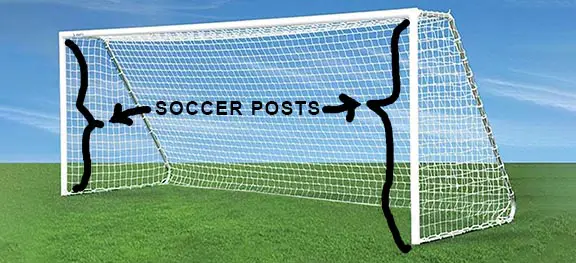 Soccer goal posts
Soccer goal postsHAND BALL. The soccer phrase hand ball refers to an illegal touch of the ball with a players hand or arm. It's up to the referees judgement on whether a handball is accidental or intended, as well as if the hand ball affected the play.
HACKING. You want to know what hacking means in soccer. Hacking occurs when there is deliberate kicking of a players shin guards by her opponent.
HAT TRICK. The phrase hat trick means a player has scored three goal in a single match. The term came originally from the game of cricket in 1858 when a player successfully takes three wickets with three consecutive deliveries.
HAUL. The definition of a haul in soccer is the scoring of 4 goals by a single player in a single soccer game.
HEADER. The word used to describe striking the ball with a part of the head. Headers are very effective ways to pass the ball to a teammate in the air as well as additional important technique to score a goal.
INDIRECT KICK. An indirect kick is one where the ball must be touched by a second player after the initial kiccker, before it can enter the goal and be counted as a legal goal that counts.
KICKOFF. When the first or second half of a soccer match begins, the kickoff is started directly in the middle of the field. The player who starts with the initial kick can not touch the ball a second time until another plyer from either team has touched it next.
LINESMAN. Also called assistant referees, linesman is the term used for the official who positions himself directly on one of the touchlines (sideline). The linesman makes the calls regarding the direction of throw ins as well as calling offsides.
MATCH. A full competitive game of soccer with two halves. In the USA we commonly call competitive matches soccer games, even though a "soccer game" can be any activity involving soccer, both competitive and non-competitive.
MIDFIELDER. This is another one of those soccer words that describes its own meaning. Be aware, that a midfielder can be an offensive midfielder or a defensive midfielder. Depending on the specific formation that a soccer coach employs, mot midfielders have certain intended levels of offensive and defensive duties that can change quickly during a match.
NUTMEG. The term used for a player successfully playing the soccer ball through the legs of the opponent and retaining possession on the other side. Nutmegs can be embarrassing to the defender who gets beat.
It's likely not a good idea to attempt to do too many nutmegs on an opponent as it can build some anger as defenders don't like to get nutmegged. Here's the complete post on soccer nutmeg.
OFFSIDES. A perfect understanding of offsides in soccer can be challenging because there are several parts that come into play that determine whether an offsides violation occurred.
A player is in an offsides position when she is closer to her opponents goal line than both the soccer ball and the second to last opponent.
Additionally, you're not in an offsides position when receiving a throw in, nor can you be offsides on your own defensive half of the field.
PENALTY AREA. The penalty areas are 44 yards wide and 18 yards deep and are located in front of the goals at each end of a full-sided soccer field. The penalty area is also called the 18-yard box.
Committing an infringement of certain rules foul by the defense in the penalty area causes a penalty kick to be awarded to the offensive team.
PENALTY KICK-PK. The term penalty kick is often abbreviated as PK. A penalty kick is a free direct kick from a spot 12 yards in front of the goal.
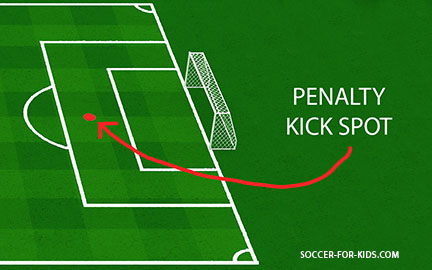 Penalty Kick Spot
Penalty Kick SpotPENALTY SHOOTOUT. A penalty kick shootout is used to determine the winner of a match after regulation time and overtime periods have resulted in a tie match. Personally, I think this arbitrary way to decide a match is a lousy way to decide a match. Five PK tries are initially allotted for each team and will continue past that if needed to decide the winner.
PUNT. When a goalie achieves possession of the ball he can throw it or punt it from within the penalty area. Similar to the punt in American football the kicker drops the ball from her hands and kicks it before it reaches the ground.
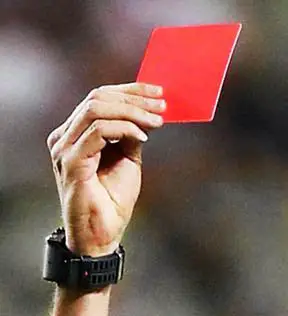 You're Outta Here!
You're Outta Here!RED CARD. A red card is issued for certain infractions of the rules. Some of these include dangerous plays, intentional handballs, being abusive to a referee.
SAVE. When an attempt to score is unsuccessful because a goalie prevented the ball from entering the goal. Goalies can use any part of their head, body, hands, arms, legs, feet to stop the soccer ball. Occasionally a non-goalie defender can perform an emergency "save" by blocking without using their hands or arms.
SET PIECE. The soccer phrase set piece means the team that is about to take a free kick has a specific, designed play already planned out (and likely practiced too). Set pieces are used frequently on corner kicks and direct kicks on the offensive side of the filed near the opponents goal.
STRIKER. Also may be referred to as a forward. The term striker comes from the developed ability of that player to strike the soccer ball with accuracy and power and score goals. Strikers are typically the player positioned as far forward as possible without being offsides.
STOPPAGE TIME. Stoppage time can also be referred to as Added Time. In soccer the play clock is not normally stopped when pla ius interrupted by an injury.
SWEEPER. In soccer the sweeper is the last line of defense before the goalie. The sweeper is positioned behind the defending fullbacks and in front of the goalie. He sweeps the ball out of the potential goal scoring spots.
The sweeper position is still popular in youth soccer, but has fallen out of favor in modern higher level of play arenas.
THROW IN. Throw ins are used to return the soccer ball back onto the playing field after it has gone out of play over one of the sidelines (touchlines). The team that did not touch the ball last before it went out is the team that gets to throw the soccer ball
It's not unusual for the youngest of soccer players struggle with using the right technique in the throw in. When that's the case, the throw in is awarded to the other team. For more on the rules parents often misunderstand, check out my post on youth soccer rules.
TACKLE. A tackle in football is defined as making a defensive stop of the opponent's progress with the soccer ball. The term tackle is not the same in soccer as a tackle is in American football where a player is brought down to the ground by grabbing, holding, or hitting their body.
TOUCHLINE. The two touchlines are the stripes along the longer side edges of the soccer field. The soccer ball must completely cross over the line to be considered out of play.
Once a soccer ball is out, the team that did NOT touch it last is awarded a throw in to continue play of the soccer match.
TRAP. When a player successfully traps the soccer ball they've stopped it and have gained control over it, making it ready to be passed, dribbled, or shot. Trapping can be done with the foot, the left, or the chest.
TRAVEL SOCCER. The phrase travel soccer usually refers to leagues that play at a level beyond the local town's recreational soccer league. Travel soccer often involve tryouts and a selection process for players with the idea of developing a higher level of play.
VOLLEY. A volley in soccer is kicking the ball in the air before it has a chance to hit the ground. A good volley is challenging to do successfully and requires precise timing, judgement, and excellent foot-eye coordination.
WALL. Particularly when it's close to one's goal, the defending team have an option of setting up several of their players in a line to act as a wall to prevent a score. The wall must be at least 10 yards from the ball's kicking spot on a free kick by the opposition. The exception to this rule is if the kick is closer then 10 yards to the goal line.
WOODWORK. The term woodwork or "hitting the woodwork" refers to the ball hitting either the cross bar or one of the goal posts. Early on soccer goals were made of wood.
WORLD CUP. The World Cup is the biggest, most presidios soccer tournament on earth. Qualifying tournaments lead to just the 32 best nations
YELLOW CARD. A yellow card is issued by the referee when a certain type of foul has been committed. It's a warning for dangerous play, for unsportsmanlike behavior, or breaking a rule. The opposition is rewarded a free kick from the spot of the foul.
Two yellow cards issued to the same player within a match automatically become a red card and a removal of the guilty player from the game.
I hope you found this glossary of soccer words helpful. Stay inspired to have a positive impact on a child!

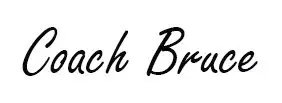
Soccer coach Bruce Lovelace started playing soccer in 1974 when, as a young boy, he constructed his own makeshift soccer goal. He played in high school, then in college and beyond. He started to coach his own children in the 1990s and then ran a Soccer Shots franchise for 12 years. Now, Coach Bruce publishes the soccer-for-kids.com website. Find out more about youth soccer coach Bruce Lovelace and what inspires this website.
Soccer-for-kids.com is a participant in the Amazon Services LLC Associates Program, an affiliate advertising program designed to provide a means for sites to earn advertising fees by advertising and linking to Amazon.com
